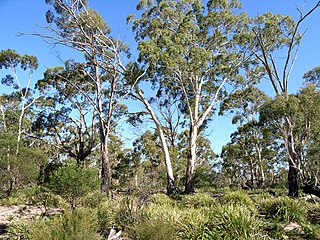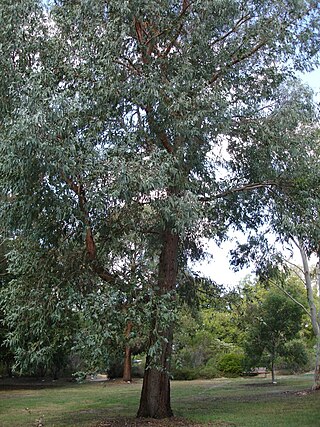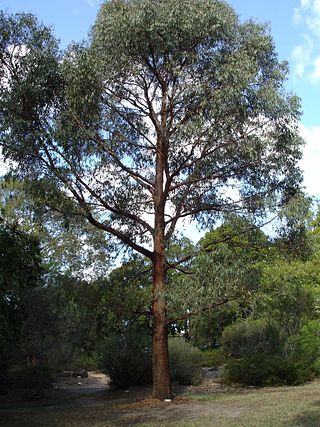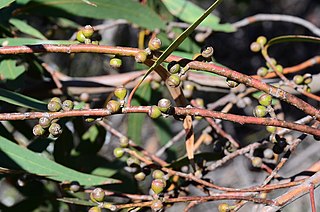
Eucalyptus viminalis, commonly known as the manna gum, white gum or ribbon gum, is a species of small to very tall tree that is endemic to south-eastern Australia. It has smooth bark, sometimes with rough bark near the base, lance-shaped to curved adult leaves, flower buds in groups of three or seven, white flowers and cup-shaped or hemispherical fruit.

Eucalyptus chapmaniana, commonly known as the Bogong gum, is a species of small to medium-sized tree endemic to montane and eastern Australia. It has rough, fibrous and fissured bark on most of the trunk and smooth light brown to grey bark often shed in long ribbons on the branches. The adult leaves are lance-shaped to curved, the flower buds in groups of three and the fruit a conical or bell-shaped capsule.

Eucalyptus radiata, commonly known as the narrow-leaved peppermint or Forth River peppermint, is a species of tree that is endemic to south-eastern Australia. It has rough, fibrous to flaky bark on the trunk and larger branches, smooth grey bark on the thinner branches, lance-shaped to curved or almost linear leaves, flower buds in groups of eleven to twenty or more, white flowers and cup-shaped, hemispherical or shortened spherical fruit.

Eucalyptus moluccana, commonly known as the grey box, gum-topped box or terriyergro, is a medium-sized to tall tree with rough bark on part or all of the trunk, smooth bark above, lance-shaped adult leaves, flower buds usually in groups of seven, white flowers and cup-shaped to barrel-shaped fruit. It is found in near-coastal areas of Queensland and New South Wales.

Eucalyptus goniocalyx, commonly known as long-leaved box, olive-barked box or bundy, is a species of small to medium-sized tree that is endemic to southeastern Australia. It has rough, fibrous or flaky bark, lance-shaped to curved adult leaves, flower buds in groups of seven, white flowers and cup-shaped, cylindrical or barrel-shaped fruit.

Eucalyptus miniata, commonly known as the Darwin woollybutt or woolewoorrng, is a species of medium-sized to tall tree that is endemic to northern Australia. It has rough, fibrous, brownish bark on the trunk, smooth greyish bark above. Adult leaves are lance-shaped, the flower buds are ribbed and arranged in groups of seven, the flowers orange or scarlet and the fruit is cylindrical to barrel-shaped or urn-shaped, with ribs along the sides.

Eucalyptus serraensis, commonly known as the Grampians stringybark, is a species of small tree or mallee that is endemic to the Grampians in Victoria, Australia. It has rough, stringy, fibrous or flaky bark on the trunk and sometimes also the branches, smooth bark above, lance-shaped to egg-shaped or round adult leaves, sessile flower buds in groups of three or seven, white flowers and hemispherical or cup-shaped fruit.

Eucalyptus aromaphloia, commonly known as Creswick apple-box, scented bark or scent-bark, is a species of plant in the myrtle family that is endemic to Victoria. It is a tree with rough, densely fibrous bark on the trunk and branches, lance-shaped or curved adult leaves, oval to spindle-shaped flower buds in groups of seven, white flowers and conical to hemispherical fruit.
Eucalyptus volcanica is a species of tree that is endemic to northern New South Wales. It has rough, fibrous to flaky bark on the trunk, smooth bark above, lance-shaped or curved adult leaves, flower buds in groups of seven, white or creamy white flowers and cup-shaped or barrel-shaped fruit.
Eucalyptus famelica is a species of mallee that is endemic to Western Australia. It has smooth grey and pale brown bark, sometimes with thin, rough, fibrous bark near the base of the trunk on larger plants. The adult leaves are lance-shaped, the flower buds are arranged in groups of seven, the flowers are creamy white and the fruit is cup-shaped to cylindrical.

Eucalyptus falciformis, commonly known as the Grampians peppermint or western peppermint, is a species of tree or mallee that is endemic to south eastern Australia. It has smooth bark, sometimes with rough, fibrous bark at the base, narrow lance-shaped to egg-shaped or curved adult leaves, flower buds in groups of eleven to twenty one, white flowers and cup-shaped to shortly cylindrical fruit.
Eucalyptus filiformis is a species of mallee that is endemic to a small area on the side of a mountain in Victoria, Australia. It has rough fibrous or flaky bark on the trunk, smooth bark above, narrow lance-shaped to narrow elliptical adult leaves, flower buds usually in groups of seven, white flowers and barrel-shaped fruit.
Eucalyptus hawkeri is a species of mallee or slender tree that is endemic to Victoria, Australia. It has rough, flaky or fibrous bark on the lower trunk, smooth bark above, lance-shaped or curved adult leaves, flower buds in groups of between seven and eleven, white flowers and cylindrical or barrel-shaped fruit.

Eucalyptus helidonica is a species of tree that is endemic to an area near Helidon in Queensland. It has rough, finely fibrous bark, lance-shaped or curved adult leaves that are paler on the lower surface, flower buds in groups of eleven or more, white flowers and shortened spherical or barrel-shaped fruit.
Eucalyptus pyrenea, commonly known as Pyrenees gum, is a species of tree that is endemic to Victoria, Australia. It has smooth, greyish bark with rough, fibrous bark on the lower part of the trunk, lance-shaped to curved adult leaves, flower buds in groups of seven, white flowers and cup-shaped fruit.
Eucalyptus carolaniae is a species of small to medium-sized tree that is endemic to a small area of Victoria. It has thick, rough, fibrous bark on the trunk grading to thin finely furrowed bark on the branches. It has glossy green, lance-shaped adult leaves, flower buds in groups of seven, white flowers and cylindrical to oval fruit.

Eucalyptus sabulosa, commonly known as Wimmera scentbark, is a species of small, spreading tree that is endemic to Victoria, Australia. It has fibrous or scaly bark on the trunk and branches, lance-shaped to curved adult leaves, flower buds in groups of seven, white flowers and oval to almost spherical fruit.
Eucalyptus silvestris is a species of mallee or small tree that is endemic to Victoria, Australia. It has rough, fibrous or flaky bark on the trunk and larger branches, smooth greyish brown bark above, glossy green, lance-shaped leaves, flower buds usually in groups of seven, white flowers and conical to cup-shaped fruit.
Eucalyptus splendens, commonly known as apple jack, is a species of small, spreading tree that is endemic to a small area of Victoria, Australia. It has fibrous or corky bark on the trunk and thicker branches, lance-shaped to curved adult leaves, flower buds in groups of seven, white flowers and hemispherical to cup-shaped fruit.
Eucalyptus yarriambiack is a species of small, spreading tree that is only known from a single population in Victoria, Australia. It has rough, fibrous to flaky bark on the trunk, smooth bark above, narrow lance-shaped to elliptical adult leaves, flower buds in groups of seven to eleven, white flowers and hemispherical to cup-shaped fruit.










